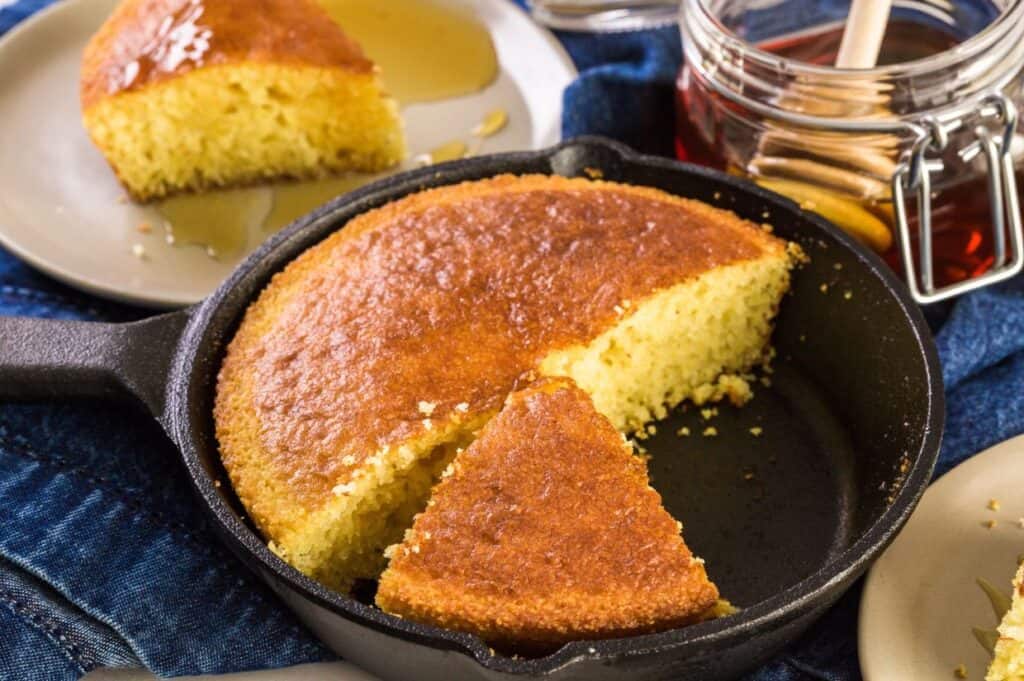Cornbread has become a staple on Southern tables, comfort food spreads, and family gatherings across the U.S., sparking a debate as divisive as whether to put sugar in your grits or ketchup on a hotdog: should cornbread be sweet or savory? Many people passionately defend keeping it rich and savory to let the corn’s natural flavor shine, while others insist that a hint of sweetness is essential. Let’s explore the history, flavors, and the ongoing sweet-versus-savory cornbread debate.

The origins of cornbread: Where did it all start?
Indigenous communities created cornbread by making flatbreads with ground corn long before European settlers arrived. Corn, a New World crop, featured prominently in their cooking, from bread to porridge. Early cornbread recipes used only cornmeal, water, and salt, producing a basic but nourishing bread.
European settlers encountered Indigenous cornbread and modified it by adding eggs, butter, and later, leavening agents like baking powder. These changes produced lighter, fluffier bread. Cornbread became a vital food in the American South, where communities relied on corn as an abundant and affordable crop during hard times. The recipe evolved differently across communities, reflecting their unique needs and tastes.
Sweet cornbread: A modern twist or a classic?
Sweet cornbread gained popularity when refined sugar became more accessible. As sugar became affordable, people began adding it to their cornbread recipes, particularly in the Northern U.S.
Sweet cornbread delivers a dessert-like quality, often enhanced with honey or sugar sprinkled on top. Its moist, cake-like texture pairs perfectly with barbecue dishes, providing a delicious contrast to smoky meats. Many enjoy it as a standalone treat, topped with butter and honey.
Savory cornbread: The classic southern staple
Southern cooks often stick to a simple recipe for savory cornbread: flour, baking soda, buttermilk, and cornmeal, sometimes with a touch of bacon grease for a traditional flavor. Savory cornbread boasts a rustic taste, a gritty texture, and a sturdy crumb, making it a perfect companion for rich dishes like collard greens, red beans, or gumbo.

Advocates of savory cornbread argue that true cornbread relies on cornmeal’s natural flavor without adding sweetness. Many enhance the bread with salt or savory ingredients like jalapeños or cheese, creating a simple yet complex flavor.
Why the divide? Regional differences and flavor preferences
The sweet-versus-savory cornbread debate stems from regional history and personal nostalgia. Sweet cornbread dominates in Northern states, where recipes frequently include sugar, honey, or molasses. This version is lighter and cake-like.
In contrast, Southern cooks favor savory cornbread, often baked in a cast-iron skillet for a crispy golden crust. Many Southerners grew up eating savory cornbread made with buttermilk and fried in bacon grease. To them, adding sugar feels like abandoning tradition.
The texture factor: Crumbly vs. Moist
Texture plays a significant role in the cornbread debate. Sweet cornbread features a moist, cake-like texture due to sugar, butter, and milk. Its smooth consistency makes it ideal for eating plain or topped with butter.
Savory cornbread, however, has a denser, coarser texture. Made with coarse cornmeal, it crumbles easily, making it perfect for soups, stews, or soaking up sauce from Southern dishes like fried chicken or black-eyed peas. For many, the coarser texture enhances the authentic cornbread experience.
The case for sweet cornbread
Supporters of sweet cornbread claim that sugar enhances the bread’s flavor and broadens its appeal. Many enjoy it as a snack or pair it with savory dishes like chili, barbecue, or coleslaw, where its sweetness balances bold flavors.

For those unfamiliar with savory cornbread, the sweet version feels like a balanced, dessert-like alternative that highlights cornbread’s versatility.
The case for savory cornbread
Fans of savory cornbread argue that sugar overwhelms the natural cornmeal flavor. For Southerners, cornbread should remain earthy, crumbly, and free from sugar — the perfect side for hearty meals like braised greens or stew.
Purists believe cornbread’s simplicity should shine. They often say that overly sweetened cornbread resembles cake rather than bread.
Can there be a middle ground?
Some cooks find a compromise by adding a small amount of sugar or honey to savory cornbread. This touch of sweetness enhances the bread’s flavor without overshadowing the cornmeal. Others experiment by incorporating savory ingredients like jalapeños, cheese, or fresh herbs into sweet cornbread recipes.
Hybrid cornbreads bridge the gap for families with divided preferences. Creative add-ins, from green onions to crispy bacon, offer endless ways to elevate cornbread.
The verdict: is there a right answer?
Ultimately, the great cornbread debate boils down to personal preference, tradition, and regional pride. Neither sweet nor savory is the “wrong” choice. Whether you prefer a sweet, cake-like slice or a crumbly, savory wedge, cornbread adapts to fit your taste and complements your meal.
Why not try both? Bake sweet and savory cornbread and see which one disappears faster. You might find yourself loving both. One thing is certain: cornbread, in all its forms, will always have a place on our tables.




